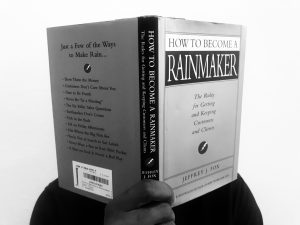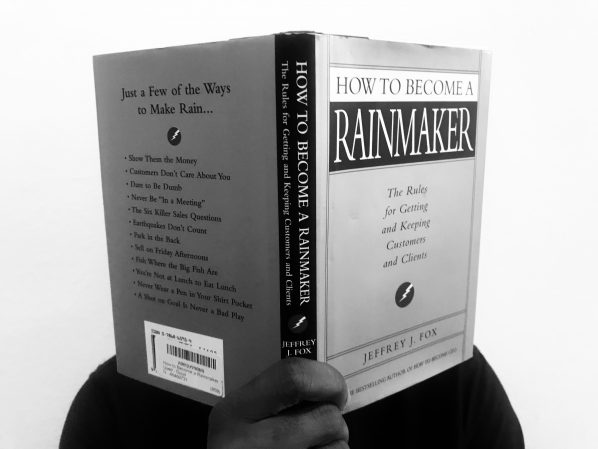“Learning is repetition”. These are the words from the Head of Sales of a $6 billion software company. This was his answer after I asked why he reads so many business books. He went on to explain that although these books may tackle similar themes, he still enjoys reading them because by repeatedly exposing himself to the different, and sometimes, conflicting perspectives of the authors, he can gain a deeper understanding of the concepts in the books. Inspired by the words of this sales leader, I’m introducing a new series where I plan to share three actionable insights from a book I’m reading every month.
 To kick things off, my book for October 2018 is “How to become a Rainmaker: The rules for getting and keeping customers and clients” by Jeffrey J. Fox. The publisher describes the book as “a winning handbook filled with short, pithy advice that will raise some eyebrows and, no doubt, some income levels as readers follow the suggestions to make it rain.” The book is only 165 pages long which means you could read it in about four hours if you average 1½ minutes per page or in less than 2 hours if you listen to it at 2X speed on Audible.
To kick things off, my book for October 2018 is “How to become a Rainmaker: The rules for getting and keeping customers and clients” by Jeffrey J. Fox. The publisher describes the book as “a winning handbook filled with short, pithy advice that will raise some eyebrows and, no doubt, some income levels as readers follow the suggestions to make it rain.” The book is only 165 pages long which means you could read it in about four hours if you average 1½ minutes per page or in less than 2 hours if you listen to it at 2X speed on Audible.
This book has a lot of insights, and below are three that resonated with me the most:
1. Find a “point system” that works for you: In Chapter XXXVII, the author encourages salespeople to use a point system every day. He breaks down the point system into four parts:
- 1 point for getting a lead, a referral, an introduction to a decision maker
- 2 points for getting an appointment to meet the decision maker
- 3 points for meeting the decision maker face-to-face
- 4 points for getting a commitment to a close or an action that leads to a close
The goal is to get 4 points every day in any combination. If you do this consistently, you will not run out of prospects, you will have a full pipeline, and you will always be making rain. I like the practicality of this because it doesn’t take much effort to get started doing it and seeing the results. Also, don’t wait till the last day of the week to try to get 20 points.
I added my variation to the point system by color coding my calendar:
- Green is meeting with clients and decision makers
- Orange is internal meeting
- Purple is internal training
- Light purple is personal development time
My goal is to have more green in my calendar every week. If I’m spending more time with clients, it means I’m helping them solve their challenges, which means I’m making it rain, which means my pasture is going to be very green. Whether you are in sales or not, define what “green” looks like to you and do more of it every week.
2. Welcome customer objections: In Chapter XV, the author explains that “rainmakers turn customer objections into customer objectives.” The play on words is brilliant. Let’s see how the dictionary defines objections and objectives.
- Objection: an expression or feeling of disapproval or opposition; a reason for disagreeing.
- Objective: a thing aimed at or sought; a goal.
When you examine both definitions closely, you realize a subtle relationship. For you to achieve any goal, you are bound to face opposition. Understanding this relationship as a salesperson should get you excited to hear your customer objections. These objections mean that they are trying to achieve a goal and they need your help to remove the oppositions in their way. One question the author encourages us to ask if a sale is not made is “what else may be prohibiting us from moving ahead?” If you’re a salesperson asking for a deal, this question works. If you’re an entrepreneur asking for funding, this question works. If you’re the president of a non-profit asking for a significant donation, this question also works. Give it a try this week.
3. Dress to impress for success: In Chapter XLV, the author advises us to “be the best-dressed person you will meet today.” It’s a simple but powerful concept. According to the author, “Rainmakers do not dress down, nor do they necessarily dress up. They dress better than the customer they will meet that day.” In Silicon Valley and Silicon Beach where T-Shirts, shorts, and sandals are the norm for Founders and Technologists, it’s easy to dress to impress without much effort. One way I’ve been able to differentiate my style is to wear a fitted blazer with matching pocket square over my customer’s branded T-Shirts, which my customers love because it makes it seem like I am part of their team, which I am. Even in intense negotiating situations, having their T-Shirt on makes it look like I’m on their side, which I am. I also like to remind my customers that I technically work for them, but my employer’s name appears on my paycheck.
 One experience that reaffirmed that wearing my customer’s T-shirt to meet with them is the right thing to do was an encounter I had at the airport in San Francisco on my way to negotiate a deal. A stranger approached me and asked if I worked at the company on my T-shirt. I said technically Yes, and we had a good laugh. He then shared some feedback with me about my customer’s product. I jotted down the feedback and shared them with my customer when I met with them. The Executive in the meeting was appreciative of this feedback, and it helped me gain trust and respect with the rest of her leadership team. Oh yea, the Executive signed the deal.
One experience that reaffirmed that wearing my customer’s T-shirt to meet with them is the right thing to do was an encounter I had at the airport in San Francisco on my way to negotiate a deal. A stranger approached me and asked if I worked at the company on my T-shirt. I said technically Yes, and we had a good laugh. He then shared some feedback with me about my customer’s product. I jotted down the feedback and shared them with my customer when I met with them. The Executive in the meeting was appreciative of this feedback, and it helped me gain trust and respect with the rest of her leadership team. Oh yea, the Executive signed the deal.
I highly recommend this book as it may remind you of concepts you may have forgotten and introduce you to other concepts that may improve your sales motion…and help you become a rainmaker.





